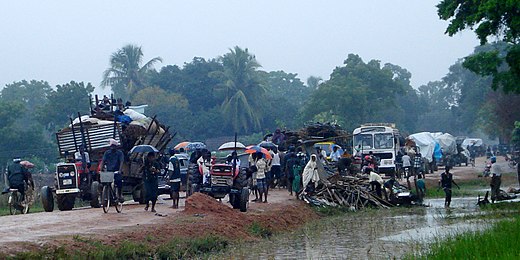13 years on, the event continues to be shrouded in mystery.
Highlights:
- Sri Lanka is in a deep political crisis 13 years after the end of the civil war.
- Tamil communities observe Mullivaikal Remembrance Day worldwide.
Sri Lanka: On the 18th of May 2009, a chilling silence fell upon a small corner in northern Sri Lanka. For 26 long years, a vicious and bloody battle raged but came to a grinding halt that morning. The last 138 days of the civil war took the lives of 40,000 with thousands more presumed dead or missing.
This is the vicious story of the ‘war with no witnesses’.

British Rule & Black July
The conflict between the Sinhalese and Tamil populations began in the nation’s colonial roots.
The British government resettled Indian-Tamil indentured workers in Sri Lanka and offered them better jobs than native Sinhalese residents. This caused a large rift between the two largest communities on the island which grew violent post-1948. The involvement of Indian forces in the war ended in the assassination of then-PM Rajiv Gandhi by LTTE suicide bombers on 21st May 1991.
The burning of Tamil homes and businesses became commonplace in the ’60s and ’70s. The violent Tamil resistance group Liberation Tigers of Tamil Eelam grew to prominence at this time. The 1981 burning of the Jaffna Public Library and the events of ‘Black July’ in 1983 are seen as starting point of the war.
The civil war raged on for 26 years, ending with the Mullivaikal Massacre in 2009.
The “No Fire Zone” (NFZ)
The government announced a small sliver of land in Mullaitivu as a “no-fire zone”. The UN estimates 200,000 people poured into 14km2 of land. The LTTE who lost other their zones of control, began retreating into the area to set up camp.

February 2009:
The same day the government announced their commitment to keeping civilian casualties at zero, a makeshift hospital experienced shelling. Puthukkudiyirippu(PTK) hospital with over 500 patients had shells dropped on it throughout the day.
The SLG( Sri Lankan Government) later declared that the shelling targeted LTTE camps as per their intel.
In the Channel4 documentary “Sri Lanka’s Killing Fields”, witnesses claim that the shelling was frequent and deadly. Human Rights Watch reported 108 casualties and 174 injuries across hospitals in the NFZ on February 5th alone. In a 2011 UN screening of the documentary, SLG officials rejected the authenticity reports of the footage claiming war crimes. The documentary and events portrayed are yet to undergo official investigation by the Sri Lankan government.
By mid-February, Mullivaikal hospitals found themselves cut off from basic resources such as anesthetics or medical gloves. Doctors resorted to amputations as even basic shrapnel cuts turned gangrenous without anti-biotics. Life-saving surgeries went on while patients were fully conscious. Conditions in makeshift hospitals worsened day by day and often shifted locations due to targeted shelling.
Meanwhile, LTTE soldiers faced accusations of shooting fleeing refugees and recruiting child soldiers as suicide bombers.
April 2009:
In April, Gotabaya Rajapaksa refused to allow aid organisations to operate or serve civilians in the NFZ. This deepened the food and medical crisis looming over refugee camps. More hospitals closed in Mullaitivu and a leaked UN document reveals at least 6,000 left dead.
The LTTE claims that at least 2,000 Multi Barrage Rocket Launchers (MBRLs) hit Mullivaikal on the 28th and 29th of April.
May 2009:
In May, Sri Lanka’s Foreign Secretary confirms that the SLA shelled the NFZ however, Mahinda Rajapaksa later contradicted that statement.
“There were many bodies everywhere and I could still smell the smoke from the shells hanging in the air. The smell of blood and the screaming from the injured was overwhelming. There were many women and children dead.”
An OHCHR Investigation on hospital bombings quoted a witness describing the scene.
By the 14th of May, the last hospital in the NFZ had closed with 150,000 people still stranded.
16th May: President Mahinda Rajapakse declared victory at the G11 summit in Jordan just two days earlier. UN estimates 100,000 still stranded in bunkers and makeshift camps with little resources as of 15th of May.
18th May 2009:
On the morning of 18th May, SLA troops re-captured the last of the NFZ camps. SLA brought in earth movers to bury the dead of Mullivaikal. Thousands of survivors fled to other camps. UN forces witnessed SLA soldiers using grenades on bunkers still full of people.
The public did not know it yet, but the leader of the LTTE, Prabhakaran, lay dead in a clearing in a forest nearby. His 12 y.o son was publicly captured and killed with footage of the execution being widely available. Many high-ranking surrendered members of the LTTE died in executions in the following hours and days.
Footage of high-profile Tamil TV presenter Isaipriya’s execution surfaced 2 years later.
The Aftermath of the Mullivaikal Massacre:
An estimated 300,000 displaced Tamil refugees existed in Sri Lanka as of May 2009. Many fled the country to resettle as diaspora across the world.
The death count in the last few months of the war remains unclear but the UN puts the estimates anywhere near 40,000-60,000. SLG considers many still missing in action .
May 18th in Sri Lanka is hailed as ‘Victory Day. By contrast, Security is tightened in Tamil dominated provinces and educational institutions are ordered shut to prevent commemoration. On the other hand, the Sri Lankan Tamil diaspora holds public gatherings with no restrictions in countries like Canada and the UK.
Read More-India denies reports of sending troops to Sri Lanka













